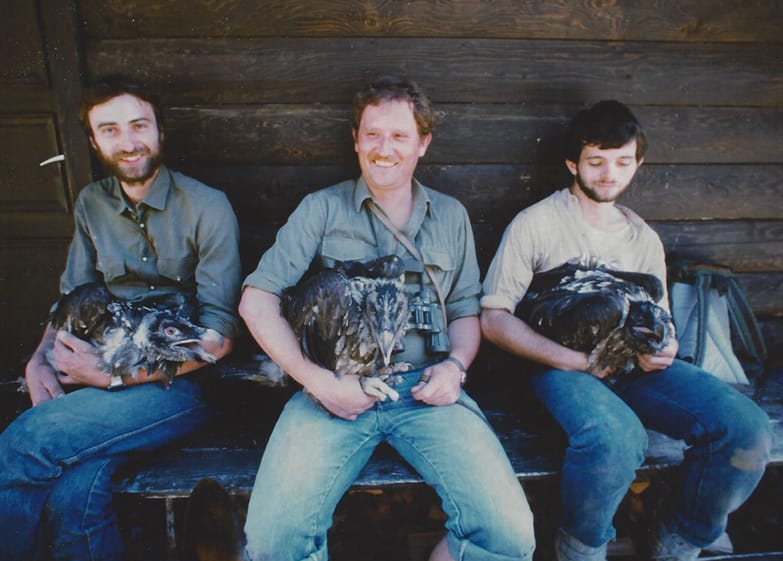
The Bearded Vulture is an exceptional vulture species that has evolved to primarily feed on the bones of animal carcasses, therefore providing unique ecosystem services.
Conservation efforts to protect the Bearded Vulture do not only aid this species but wider conservation and rewilding goals. As an umbrella species, by safeguarding the mountain habitat for the Bearded Vulture, other mountain wildlife benefits too, such as golden eagles and ibex. Further to this, as scavengers, they do not kill livestock or game species, and thus, there is not much human-wildlife conflict. So, it is possible to collaborate with multiple stakeholders such as livestock breeders and hunters to tackle threats they face, such as poisoning, which poses a severe threat to wildlife and public health.
The Vulture Conservation Foundation (VCF) aims to see the return of the Bearded Vulture to its former range across Europe, and it has been working to achieve this for decades now. Based on a captive-breeding programme, the VCF and its partners released hundreds of birds on different European regions and managed to bring the species back to the Alps after their extinction.
The return of the Bearded Vulture to the Alps
The species was driven to extinction in the Alps during the 20th Century, and to bring them back, pioneers from all Alpine countries initiated the reintroduction project in the 1970s. The Foundation for the Conservation of Bearded Vultures (FCBV), now VCF, was established to help coordinate these efforts and achieve this goal. Four national parks, stretched across the Alpine region at 200-300 km apart, were selected as suitable areas for release of the Bearded vultures. The first birds were released in 1986 at Hohe Tauern National Park (Austria), and in 1997 the first breeding pair successfully raised a chick in the wild in Haute-Savoie in France.
This reintroduction project has sparked the imagination and gathered the support of many stakeholders across the Alpine chain and is considered one of the best wildlife comeback stories of all times! Because of this high success and the experience gained, a new reintroduction project started in 2005 in Andalucia, Spain – where the species is also breeding in the wild again! Since then, more similar projects were initiated.
Strengthening the Bearded Vulture population in Europe
The Bearded Vulture is Europe’s rarest vulture. Over the 19th and 20th Centuries, the species suffered a massive decline and became extinct in different European areas due to intense persecution and other threats such as lack of food. To reintroduce or strengthen their local populations, the VCF tackles threats and releases captive-bred birds in the wild.
Between 1986 and 2019, a total of 323 juvenile Bearded Vultures have been released into the wild to boost local populations in the following areas:
- 227 in the Alps & Pre-Alps
- 63 in Andalucia
- 20 in Grands Causses
- 3 in Sardinia
- 6 in Corsica
- 4 in Maestrazgo
All these projects are entirely successful only when populations reach a demographic balance, where numbers remain stable without the necessity of new introductions. By establishing ‘corridors’, connecting the populations, the VCF tries to ensure the expansion of vultures into all suitable habitat in Europe.
Captive-breeding Bearded Vultures
The Vulture Conservation Foundation (VCF) coordinates the Bearded Vulture Captive Breeding Network (EEP) of zoos, specialised breeding centres, recovery centres and private collections on behalf of EAZA. This involves closely working with our colleagues across Europe to ensure the best breeding results from the 178 birds within the Network. Thanks to this network, a total of 560 juveniles were produced between 1978 – 2019, of which many were released to the wild. Breeding chicks in captivity is not an easy or quick task. In fact, it takes a lot of expertise, commitment and diligence.
We have produce a video showcasing what it takes to breed Bearded Vultures in captivity featuring a chick with a special story. The video details the preparation for the breeding season of foster male and breeding pairs, as well as the whole management process of the eggs and chicks. In this video, the chicks were artificially incubated, a method that was thought inconceivable a few of years ago!
The Bearded Vulture breeding season is underway with chicks hatching. We first reported on the breeding season kicking-off in early October, the egg laying period starting in December and the first chick hatching in January! To follow the news of the breeding season, follow #BeardedVultureBreedingSeason on Facebook, Twitter and Instagram.
Together we can save vultures! It takes a lot of dedication, work and collaboration, but we must protect our vultures and other wildlife as they are an essential part of our environment and provide many benefits to nature, but also people!
World Wildlife Day, do one thing today

Today, on 3rd March 2020, is #WorldWildlifeDay! World Wildlife Day celebrates the many beautiful and varied forms of wild fauna and flora, and aims to raise awareness of the multitude of benefits that their conservation provides to people. At the same time, the Day reminds us of the urgent need to step up the fight against wildlife crime and human-induced reduction of species, which have wide-ranging economic, environmental and social impacts.
The theme of World Wildlife Day 2020, “Sustaining all life on Earth”, encompasses all wild animal and plant species as a component of biodiversity, as well as the livelihoods of people, especially those who live closest to nature.
You can #DoOneThingToday to help wildlife. Become part of the conversation and share related news, including this blog post, to raise awareness on the issues. You can also help us continue our conservation work by donating to the VCF.









